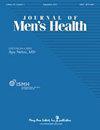Low-frequency neuromuscular electrical stimulation as a treatment for anejaculation caused by iatrogenic injury of the abdominal aorta: a case study
IF 0.6
4区 医学
Q4 Medicine
引用次数: 0
Abstract
Anejaculation is the inability to ejaculate during sexual activity, either in an antegrade or retrograde fashion. Both anejaculation following an iatrogenic injury of the abdominal aorta and the efficacy of low-frequency neuromuscular electrical stimulation (NMES) in treating anejaculation have been reported rarely. In this case report, we describe a patient who experienced anejaculation following an iatrogenic injury to the abdominal aorta and eventually regained normal ejaculation ability following treatment with NMES. The patient, a 23-year-old Chinese man, underwent laparoscopic varicocele ligation on both sides, during which he sustained a ruptured wound in the abdominal aorta from a 10-mm trocar. To stop the bleeding, he underwent abdominal aortic balloon catheter dilatation combined with covered stent implantation. However, 10 days after the endovascular interventions, the patient developed hemorrhagic shock and underwent emergency exploratory laparotomy and adventitial suture of the abdominal aorta. Despite normal erectile function since a week after the last surgery, the patient complained of aejaculation for a year during intercourse or masturbation. After receiving NMES treatment for over two months, the patient reported successful intravaginal ejaculation during intercourse, and the improvement persisted for a month after treatment. Altogether, these findings suggest that NMES could be a feasible, safe, and cost-effective treatment method for improving anejaculation and provides a novel option for patients with this condition.低频神经肌肉电刺激治疗医源性腹主动脉损伤引起的射精:个案研究
射精是指在性活动中不能射精,无论是顺行还是逆行。医源性腹主动脉损伤后的射精和低频神经肌肉电刺激(NMES)治疗射精的疗效都很少报道。在本病例报告中,我们描述了一位在医源性腹主动脉损伤后经历射精的患者,并最终在NMES治疗后恢复了正常射精能力。该患者是一名23岁的中国男子,他接受了腹腔镜下双侧精索静脉曲张结扎术,在此过程中,他的腹主动脉被一个10毫米的套管针扎破。为了止血,他接受了腹主动脉球囊导管扩张联合覆膜支架植入术。然而,在血管内干预10天后,患者发生失血性休克,并接受了紧急剖腹探查和腹主动脉外膜缝合。尽管自上次手术后一周勃起功能正常,但患者在性交或手淫时抱怨射精一年。在接受NMES治疗两个多月后,患者报告性交时阴道内射精成功,治疗后改善持续了一个月。总之,这些发现表明,NMES可能是一种可行、安全、经济的治疗方法,可以改善射精,为这种疾病的患者提供了一种新的选择。
本文章由计算机程序翻译,如有差异,请以英文原文为准。
求助全文
约1分钟内获得全文
求助全文
来源期刊

Journal of Men's Health
Medicine-Urology
CiteScore
0.70
自引率
28.60%
发文量
153
审稿时长
10 weeks
期刊介绍:
JOMH is an international, peer-reviewed, open access journal. JOMH publishes cutting-edge advances in a wide range of diseases and conditions, including diagnostic procedures, therapeutic management strategies, and innovative clinical research in gender-based biology. It also addresses sexual disparities in health, life expectancy, lifestyle and behaviors and so on. Scientists are encouraged to publish their experimental, theoretical, and descriptive studies and observations in as much detail as possible.
 求助内容:
求助内容: 应助结果提醒方式:
应助结果提醒方式:


